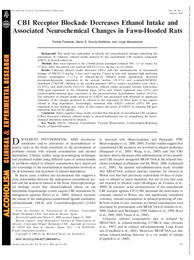Please use this identifier to cite or link to this item:
https://hdl.handle.net/11000/35373Full metadata record
| DC Field | Value | Language |
|---|---|---|
| dc.contributor.author | Femenía Cantó, Teresa | - |
| dc.contributor.author | García Gutiérrez, María Salud | - |
| dc.contributor.author | Manzanares, Jorge | - |
| dc.contributor.other | Departamentos de la UMH::Farmacología, Pediatría y Química Orgánica | es_ES |
| dc.date.accessioned | 2025-01-28T12:01:07Z | - |
| dc.date.available | 2025-01-28T12:01:07Z | - |
| dc.identifier.citation | Alcoholism, clinical and experimental research; 2010;34(1):131-141 | es_ES |
| dc.identifier.issn | 0145-6008 | - |
| dc.identifier.issn | 1530-0277 | - |
| dc.identifier.uri | https://hdl.handle.net/11000/35373 | - |
| dc.description.abstract | Background: This study was undertaken to identify the neurochemical changes underlying the attenuation of voluntary ethanol intake induced by the cannabinoid CB1 receptor antagonist AM251 in fawn-hooded rats. Methods: Rats were exposed to the 2-bottle-choice paradigm (ethanol 10% v ⁄ v or water) for 15 days. After this period, rats received AM251 (3 to 6 mg ⁄ kg, i.p.) or vehicle. Results: Voluntary ethanol intake decreased (30%) with the administration of incremental dosages of AM251 (3 mg ⁄ kg, 5 days and 6 mg ⁄ kg, 5 days) in rats with acquired high preferring ethanol consumption (>3.5 g of ethanol ⁄ kg ⁄ d). Ethanol intake significantly decreased proopiomelanocortin expression in the arcuate nucleus (38.31%) and l-opioid-DAMGOstimulated [35S]-GTPc binding in the caudate-putamen (40%), nucleus accumbens core (AccC) (32.87%), and shell (AccS) (34.21%). Moreover, ethanol intake increased tyrosine hydroxylase (TH) gene expression in the substantia nigra (24%) and ventral tegmental area (23%) and corticotrophin-releasing gene expression in the paraventricular hypothalamic nucleus (41.6%). The reduction of ethanol intake induced by AM251 was associated with blockade or significant reduction of the changes produced by ethanol in the expression of these genes in key regions related to drug dependence. Interestingly, treatment with AM251 reduced (20%) TH gene expression in rats drinking only water. In this respect, the action of AM251 in reducing TH gene expression may not be specific. Conclusion: Taken together, these results revealed that blockade of cannabinoid CB1 receptors (CB1r) decreased voluntary ethanol intake in ethanol-habituated rats by normalizing the neurochemical alterations induced by ethanol. | es_ES |
| dc.format | application/pdf | es_ES |
| dc.format.extent | 11 | es_ES |
| dc.language.iso | eng | es_ES |
| dc.publisher | John Wiley & Sons | es_ES |
| dc.rights | info:eu-repo/semantics/openAccess | es_ES |
| dc.rights.uri | http://creativecommons.org/licenses/by-nc-nd/4.0/ | * |
| dc.subject | AM251 | es_ES |
| dc.subject | Ethanol | es_ES |
| dc.subject | Cannabinoid | es_ES |
| dc.subject | Tyrosine Hydroxylase | es_ES |
| dc.subject | Corticotrophin-Releasing Factor | es_ES |
| dc.subject | l-Opioid Receptor | es_ES |
| dc.subject.other | CDU::6 - Ciencias aplicadas::61 - Medicina::615 - Farmacología. Terapéutica. Toxicología. Radiología | es_ES |
| dc.title | CB1 Receptor Blockade Decreases Ethanol Intake and Associated Neurochemical Changes in Fawn-Hooded Rats | es_ES |
| dc.type | info:eu-repo/semantics/article | es_ES |
| dc.relation.publisherversion | 10.1111/j.1530-0277.2009.01074.x | es_ES |

View/Open:
CB1 Receptor Blockade Decreases Ethanol Intake and Associated Neurochemical Changes in Fawn-Hooded Rats.pdf
416,39 kB
Adobe PDF
Share:
.png)
